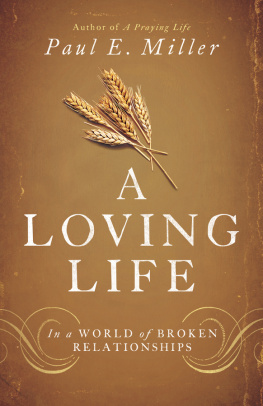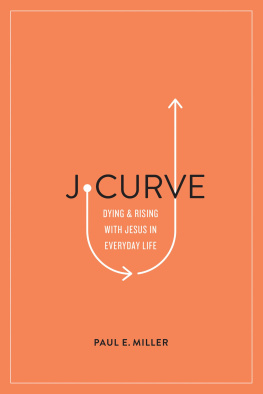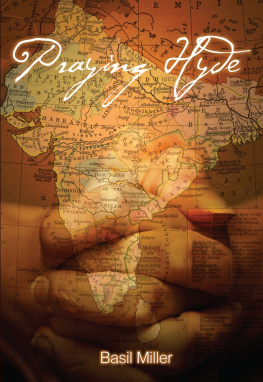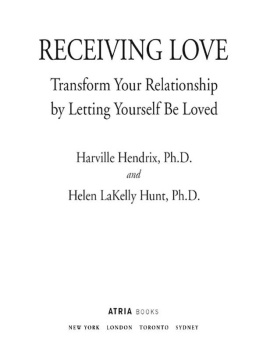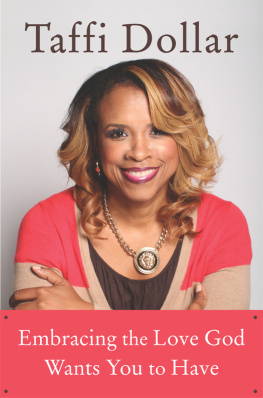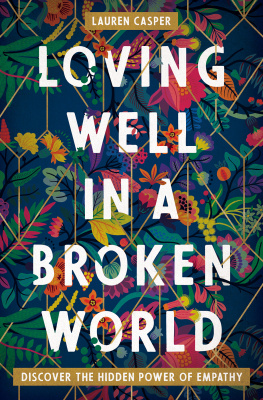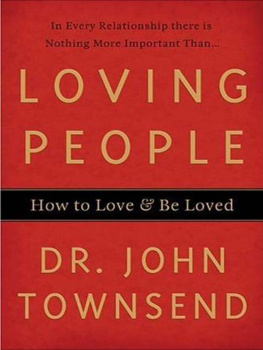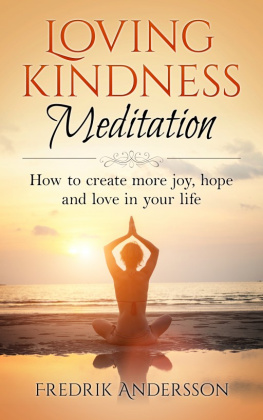Thank you for downloading this Crossway book.
Sign-up for the Crossway Newsletter for updates on special offers, new resources, and exciting global ministry initiatives:
Crossway Newsletter
Or, if you prefer, we would love to connect with you online:
Facebook
Twitter
Google +
A Loving Life: In a World of Broken Relationships
Copyright 2014 by Paul E. Miller
Published by Crossway
1300 Crescent Street
Wheaton, Illinois 60187
All rights reserved. No part of this publication may be reproduced, stored in a retrieval system, or transmitted in any form by any means, electronic, mechanical, photocopy, recording, or otherwise, without the prior permission of the publisher, except as provided for by USA copyright law.
Cover design: Faceout Studio, www.faceoutstudio.com
Cover image: Shutterstock.com
First printing 2014
Printed in the United States of America
Unless otherwise indicated, Scripture quotations are from the ESV Bible (The Holy Bible, English Standard Version), copyright 2001 by Crossway. 2011 Text Edition. Used by permission. All rights reserved.
Scripture references marked NIV are taken from The Holy Bible, New International Version, NIV. Copyright 1973, 1978, 1984 by Biblica, Inc. Used by permission. All rights reserved worldwide.
All emphases in Scripture quotations have been added by the author.
Trade paperback ISBN: 978-1-4335-3732-5
PDF ISBN: 978-1-4335-3733-2
Mobipocket ISBN: 978-1-4335-3734-9
ePub ISBN: 978-1-4335-3735-6
Library of Congress Cataloging-in-Publication Data
Miller, Paul E., 1953
A loving life : in a world of broken relationships / Paul E. Miller.
1 online resource
Includes bibliographical references and index.
Description based on print version record and CIP data provided by publisher; resource not viewed.
ISBN 978-1-4335-3733-2 (pdf) ISBN 978-1-4335-3734-9 (mobi) ISBN 978-1-4335-3735-6 (epub) ISBN 978-1-4335-3732-5 (tp)
1. Bible. RuthCriticism, interpretation, etc. 2. LoveBiblical teaching. 3. LoveReligious aspectsChristianity. I. Title.
BS1315.52
222'.3506dc23
2013029345
Crossway is a publishing ministry of Good News Publishers.
CONTENTS
Naomis initial strategy to sacrifice her own future for the sake of her daughters-in-laws future fails. Their hesed of her cant be broken, so she pulls out all the stops in this brilliant, grief-stricken argument:
But Naomi said, Turn back, my daughters; why will you go with me? Have I yet sons in my womb that they may become your husbands? Turn back, my daughters; go your way, for I am too old to have a husband. If I should say I have hope, even if I should have a husband this night and should bear sons, would you therefore wait till they were grown? Would you therefore refrain from marrying? No, my daughters... (Ruth 1:1113)
At the heart of Naomis argument is an ancient form of Social Security called levirate marriage. If a womans husband died, his brother was obligated to marry her, to take her as a second wife. Any children she had by him would receive her first husbands inheritance. This law not only saved a wife from famine, but provided heirs for the deceased husband and continued his name.
Naomi is implying that if she were to give birth to more sons, then she would give them to Ruth and Orpah as husbands. But Naomi is not pregnant, and she is too old to have children. She brings home her point by sketching out an incredible, multilevel miracle. If she were to (1) get married that night and (2) become pregnant with (3) twin (4) boys (5) on her wedding night, it would still be too long for Ruth and Orpah to wait. Ruth and Naomi are likely in their late twenties. If they were to wait another eighteen years for the hypothetical miracle boys to grow up, they would be in their midforties, too old to have children and with their lives mostly gone.
Naomi answers her own question as to whether they would wait with an emphatic Absolutely not! She paints a situation as bleak as possible in order to help Ruth and Orpah see how hopeless their situation would be with her. Face the facts. Im as good as dead.
Making the case so strongly with her daughters forces Naomi to think about how awful her own life is. Her heart breaks and grief pours out: No, my daughters, for it is more bitter for me than you that the hand of the L ORD has gone out against me (1:13). Libbie Groves puts it this way:
Naomi is an Israelite, one of Yahwehs own children, and yet his hand has persecuted her. There is deep, ancient, forever-binding covenantal anguish in her complaint. Yahweh is her God, and yet he is against her. He has not only allowed but orchestrated the mini-holocaust of which she is the sole survivor, left destitute and without hope. That hurts! You might expect to be treated badly by some stranger, but not by your dad.
What Can We Say to Naomis Lament?
Naomi makes us, with our Western cultural roots, a little nervous with her seeming disrespect of God. Yes, her life is hard, but should she blame God? Her open passion sends shivers down our stoic-tuned religious sensibilities, and we instinctively clamp down with our theology and say, Naomi, God is orchestrating this. Hes in control. Dont blame him. Her grief and anger unsettle us and open doors to unbelief in our own lives. Wed rather quiet her with good theology. We think were comforting her, but maybe were trying to keep our own demons in place.
How does God respond to her accusations? In the context of the whole book of Ruth, Ruths love is Gods response to Naomis lament. God often uses human agents to show his love. So God weeps with her: Then they lifted up their voices and wept again (Ruth 1:14).
I remember many years ago at a pastors conference, a pastor opened up his heart and shared his struggles with cynicism and unbelief. He lamented, What about me? What do I do with my heart? The other pastors began offering adviceall except one young missionary. He was so troubled, he interrupted them and said, Our brother doesnt need advice; he needs someone to weep with him. Then he burst into tears and prayed for the struggling pastor. It transformed the conference.
What can we say to Naomis lament? Nothing. Absolutely nothing. We just weep with her. That is good theology, to weep with those that weep. God does not lecture Naomi. Nor should we lecture those who are grieving. It is a striking example of Jesuss command to judge not (Matt. 7:1). Oddly enough, good theology drives Naomis frustration with God. She feels anguish precisely because she believes God is in control. In contrast, paganism resigns itself to the hand that fate deals us.
It is easy to have the wrong kind of resignation to suffering. In A Praying Life I tell the story of how our daughter Kim would pace in the early morning because of her autism. My wife, Jill, would yell at Kim to go back to bed, and I would ignore Kim, just trying to get some sleep. On the surface, Jills yelling seems less spiritual than my silence, but the opposite is true. Jill was passionately engaged with something that wasnt working. I shut it out. God can work with the former, not the latter. He can work with something that is moving, but not when our head is (literally) under the pillow. In fact, it was only because Jill yelled that I finally began to pray with Kim regularly.

